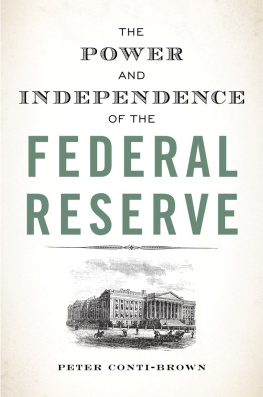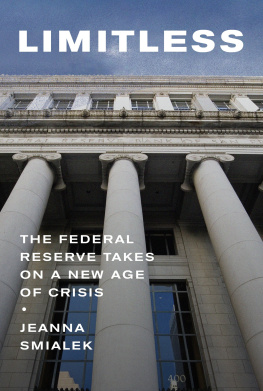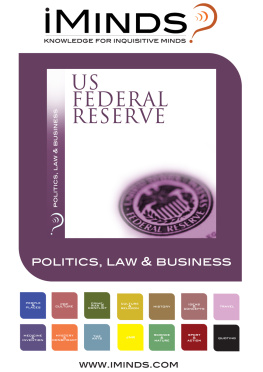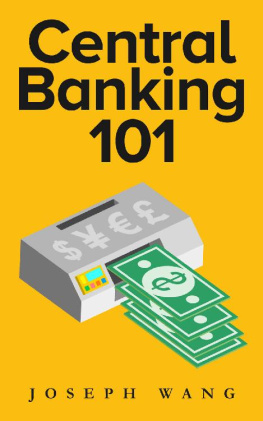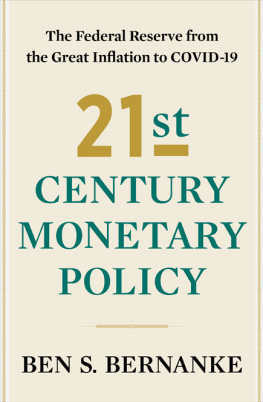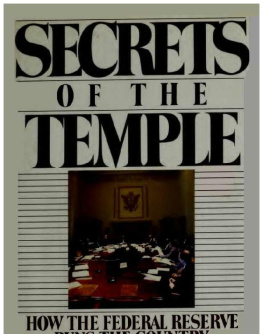THE POWER AND INDEPENDENCE OF THE FEDERAL RESERVE
THE POWER AND INDEPENDENCE OF THE FEDERAL RESERVE
PETER CONTI-BROWN
PRINCETON UNIVERSITY PRESS
PRINCETON AND OXFORD
Copyright 2016 by Princeton University Press
Published by Princeton University Press, 41 William Street,
Princeton, New Jersey 08540
In the United Kingdom: Princeton University Press, 6 Oxford Street,
Woodstock, Oxfordshire OX20 1TW
press.princeton.edu
All Rights Reserved
Library of Congress Cataloging-in-Publication Data
Conti-Brown, Peter, 1981
The power and independence of the Federal Reserve / Peter Conti-Brown.
pages cm
Includes bibliographical references and index.
ISBN 978-0-691-16400-7 (hardback)
1. United States. Federal Reserve Board. 2. Federal Reserve banks. 3. Banks and banking, CentralUnited States. 4. Monetary policyUnited States. 5. United StatesEconomic policy. I. Title.
HG2563.C596 2016
332.110973dc23 2015019984
British Library Cataloging-in-Publication Data is available
This book has been composed in Sabon LT STD & Avenir.
Printed on acid-free paper.
Printed in the United States of America
1 3 5 7 9 10 8 6 4 2

TO MY
CONTI-BROWNS,
AND TO
JULIAN ZELIZER

CONTENTS
CHAPTER 1
The Three Foundings of the Federal Reserve |
CHAPTER 2
Leadership and Institutional Change: From Periphery to Power |
CHAPTER 3
Central Banking by Committee: The Authority of the Feds Board of Governors |
CHAPTER 4
The Double Government of the Federal Reserve: The Economists and the Lawyers |
CHAPTER 5
The Vestigial and Unconstitutional Federal Reserve Banks |
CHAPTER 6
Practicing Monetary Policy: The Rise and Fall of the Chaperone |
CHAPTER 7
The Once and Future Federal Reserve: The Feds Banking Functions |
CHAPTER 8
The President and the Federal Reserve: The Limits of Law and the Power of Relationships |
CHAPTER 9
Congress and the Fed: The Curious Case of the Feds Budgetary Autonomy |
CHAPTER 10
Club Fed: The Communities of the Federal Reserve |
CHAPTER 11
Proposals |
CONCLUSION:
THE FREEMASONS AND THE FEDERAL RESERVE |
PREFACE
Two hosts of eager disputants on this subject ask of every new writer the one questionAre you with us or against us? And they care for little else.
Walter Bagehot, 1873
There is an old story, perhaps apocryphal, in which the Fed Chair greets a newly appointed member of the Board of Governors of the U.S. Federal Reserve System with an apologetic explanation of the new governors status. The chair predicted that when the man introduced himself back home to his friends and family as a governor of the Federal Reserve, they were likely to think he was the administrator of the U.S. governments unexplored western forests.
There was a time when that story was amusing. The Fed used to be an obscure, backwater government agency. The general public didnt really know what the Fed was about and probably didnt much care. Even for those who paid attention to the economy, until roughly the early 1960s the prevailing view was that the president and his administration were the first and last stop for economic policy. Central banking was in the hinterland; fiscal policythe stuff of taxes and budgets and spending and deficitswas at the core. Bankers cared about the Feds obscure activities. The rest of the country wasnt paying attention.
But where public knowledge of the Feds existence has dramatically improvedpeople know the Federal Reserve deals with money, not forestspublic knowledge of the Feds structure and functions has not. The problem is not simply one of public ignorance, though there is plenty of that. The problem is that the Fed is one of the most organizationally complex entities in the federal government, with some of the most varied missions to accomplish tucked inside. The core questions about the Fedhow it is structured, who pulls its many levers of power, and to what endare cloaked in opacity. Even the experts who study the Fed are left confused by the set of institutions that has survived the Feds sweep through a century of history.
This book is an effort to cut through that morass of law and history. The focus, as the title indicates, is especially on how the Fed gained and uses its extraordinary power over the global economy and what is meant by the often invoked but rarely explained term independence. Power here refers to the incontestable fact of the Feds ability to influence every individual, institution, or government that interacts with the global financial system. If you have a mortgage, a car payment, or a credit card, the Fed had power over its terms. Every foreign government in financial crisis has felt its influence. Private banks are deeply connected to the Federal Reserve System. And as we all saw in the 2008 financial crisis, policy failures and triumphs within the Federal Reserve stirred financial havoc but likely spared us from financial cataclysm.
As we shall see, central bankers love metaphors, so let me begin this book with one of my own. My six-year-old son spends a lot of time writing and illustrating comic books whose quality long ago left me in their artistic dust. But when the heroes and villains fight, as they invariably do, the details defy even his artistic ability. He hasnt quite mastered the depiction of motion in two dimensions, and his protagonists inevitably disappear behind a mass of scribbles. Occasionally a head or a limb will sneak out from behind the bustle of color, but the fight itself is never for the viewer to glimpse in detail. We see only what goes in, who comes out, and that something dizzying happens in between.
Many discussions of the power and structure of the Federal Reserve occur behind a mass of scribbles. There is enough that we can see sticking out of the commotion to create common assumptions to support a debatea reference to central bankers long tenure shows up here, the Feds budgetary autonomy sneaks out there, public opprobrium for politicians who attempt to dictate monetary policy makes an appearance, as does fear that central banks are wresting control of fiscal policy. But so much about these fundamental concepts of public governance occur behind an inscrutable mass.
This book steps behind the scribbles to depict the Federal Reserve, its internal structure, its external pressures, and the technical and nontechnical ways it makes its many policies, with more clarity than these questions usually receive. One of the barriers to this clarifying effort is, ironically, the very enthusiasm this subject creates in those likely to read a book titled The Power and Independence of the Federal Reserve. This is especially true in the years since the financial crisis of 2008. There is a strong temptation to become, as the epigraph suggests, eager disputants who demand an answer on where the author of such a book stands with respect to the Feds virtues and vices, its independence and accountability, indeed its very existence. For such readers, these are yes-or-no questions. Anything more seems an equivocation.
This book is an effort to push back against the certainty of those absolutist narratives. To understand the unique place the Fed occupies at the intersection of financial markets and the U.S. government requires a dive into the very meaning of this curious intellectual and institutional construction, Federal Reserve independence. But trying to make sense of the Federal Reserve and its extraordinary power with yes-or-no questions about independenceis the Fed independent? Should it be independent?is an impossible task: independence, I argue, is a concept without much analytical content. This book argues instead that we must go deeper before we can draw the Fed out from behind this veil of mystery where it has so long remained. To put the point differently, before we can judge the Fed, we must first understand it.
Next page
